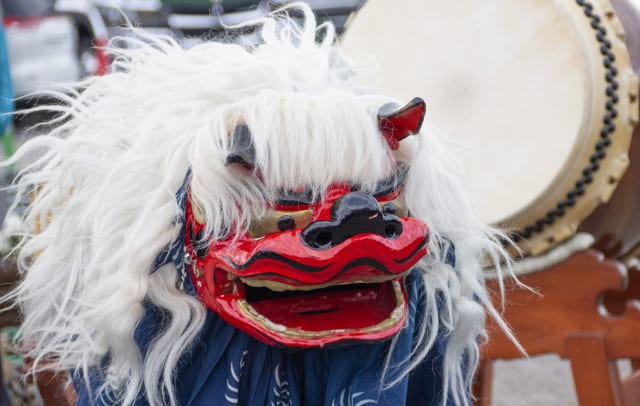Japan is renowned for its rich cultural heritage, with countless traditions celebrated around the world. Among these, one of the most iconic and visually captivating is Shishimai, also known as the lion dance.
Many people may have seen Shishimai performed at Japanese festivals, where a lion figure, often with a red head, dances energetically to music. But what exactly is Shishimai? Where did it come from, and why is it considered lucky to be bitten by the lion?
In this article, we’ll explore the history and characteristics of Shishimai, as well as the significance of being “bitten” by the lion during a performance. Even if you’re new to Japanese culture, this guide will provide you with all the essential information to appreciate this fascinating tradition.
What Is Shishimai?

Origins and History of Shishimai

The origins of Shishimai can be traced back to ancient India and China, where lions were seen as sacred creatures symbolizing protection and good fortune. This cultural practice traveled along the Silk Road and reached Japan during the Nara period (around the 7th century).
In Japan, Shishimai evolved into a unique performance art influenced by Shinto beliefs. It became a ritual performed to ward off evil spirits, bring good luck, and ensure a bountiful harvest. Today, Shishimai is most commonly performed during the New Year and at various festivals, symbolizing the renewal of luck and prosperity.
Types of Shishimai and Regional Variations


Shishimai performances in Japan can generally be divided into two main types:
- Solo Shishimai: A single performer operates the lion head.
- Group Shishimai: Multiple performers control the lion costume, creating dynamic, lifelike movements.
Each region in Japan has its unique style of Shishimai. For example, in the Kanto region, the performances are more dynamic and interactive, often engaging with the audience. Meanwhile, in the Kansai region, Shishimai is deeply rooted in Shinto rituals, creating a solemn and sacred atmosphere.
The Role and Meaning of Shishimai

Shishimai serves as both a form of entertainment and a spiritual ritual. It is believed to ward off misfortune and attract positive energy. The intricate movements of the lion, accompanied by traditional music, are not just visually impressive—they carry a deeper spiritual significance, fostering unity within communities.
Why Is Being Bitten by the Lion Lucky?

The Symbolism of the Lion’s Bite
When a Shishimai lion “bites” a person, it is said to devour their bad luck and negative energy. This act symbolizes purification and the beginning of a fortunate year.
Many people actively seek out the lion during performances, hoping to be bitten and blessed with good health and happiness.

I always loved being bitten by Shishimai!
Special Meaning for Children
When children are bitten by the lion, it is believed to promote their healthy growth and protect them from harm. This tradition is particularly cherished by parents, who often encourage their children to approach the lion for a symbolic bite.
Etiquette and Experience
To be bitten by the Shishimai lion, simply offer your head, hand, or shoulder in a relaxed manner. Some regions even have specific phrases or customs associated with the act, such as expressing gratitude to the performers.
Shishimai in Modern Times


Now let’s learn about Shishimai in modern times!
Shishimai at Festivals and Local Events

Shishimai remains a vital part of Japan’s cultural events. You can often see it at local festivals, shopping district celebrations, and New Year’s ceremonies. The lively dances and music create an exciting atmosphere, drawing in audiences of all ages.
Shishimai Abroad

Shishimai has become a beloved spectacle at international Japanese festivals. Events in the United States, Europe, and beyond often include Shishimai performances, allowing people to experience this unique tradition firsthand.
Preservation Efforts by Shishimai Associations

To preserve this cultural heritage, many local communities have established Shishimai preservation groups. These organizations focus on training younger generations, ensuring the dance, techniques, and traditions are passed down for years to come.
Shishimai Q&A
- QWhen did Shishimai first appear in Japan?
- A
Shishimai was introduced to Japan during the Nara period (7th century), having originated in India and China.
- QWhy is it lucky to be bitten by the lion?
- A
The lion’s bite is believed to remove bad luck and bring blessings of health and happiness.
- QAre there different types of Shishimai?
- A
Yes, there are solo performances and group performances, with variations in style across different regions in Japan.
Conclusion
Shishimai is not just a beautiful and energetic performance—it is a vital piece of Japan’s cultural identity. By understanding its history, symbolism, and modern significance, you can gain a deeper appreciation for this traditional art form.
If you ever have the chance to see a Shishimai performance, don’t hesitate to participate by offering yourself to be “bitten.” It’s a fun and meaningful way to experience Japanese culture while receiving a symbolic blessing of good fortune.
If you are interested in Shishimai, there’s a cute “Dancing Shishimai”.
This online store has Global Express service and you can buy this from abroad!


![[商品価格に関しましては、リンクが作成された時点と現時点で情報が変更されている場合がございます。] [商品価格に関しましては、リンクが作成された時点と現時点で情報が変更されている場合がございます。]](https://hbb.afl.rakuten.co.jp/hgb/42a19e89.29b40965.42a19e8a.e56f14cf/?me_id=1256994&item_id=10204660&pc=https%3A%2F%2Fthumbnail.image.rakuten.co.jp%2F%400_mall%2Fauc-yorozuya%2Fcabinet%2Flpet%2Flic%2Fpar-160059.jpg%3F_ex%3D240x240&s=240x240&t=picttext)



Comments